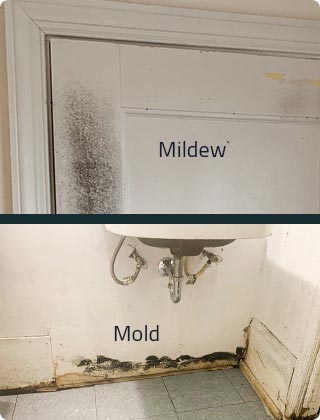MENU


According to recent CDC estimates, there are over 10,000 types of mold that can grow indoors. However, if you have ever tried to figure out the type of mold you have in your house or office, you might have come across the term mildew.
We're sure you would have been unsuccessful in your quest to learn the mold type without professional help. But, we can answer some of the questions that might have gone unanswered in your mind.
What is mildew? Is it any different from mold? Is it more or less dangerous? How can I kill mold and mildew? What's the difference between mold and mildew? Don't worry. We have all the answers you seek.
But before we jump into all the details, let's tell you what mold and mildew are. Mildew is a specific type of mold that has a flat growth. It usually grows on damp materials or in damp areas. On the other hand, mold is a fungus with multiple identical nuclei that can grow in different areas like inside food and walls.
With this basic definition, you can begin to see a picture of the difference between the two. However, you need more details to deal with these problems and live your best life.
Mold and mildew are both fungi. It follows that you can have mold or mildew for similar reasons. The general cause for both is excessive moisture in a warm environment.
So, you probably have that mold or mildew growth because of a recent flood or constant moisture exposure in a particular area. A rise in humidity can also invite mold and mildew.
But, mildew does not always grow in the same places as mold. Mildew usually starts growing in places like paper, leather, and fabrics. Mildew can also grow on food like potatoes. Mold, on the other hand, grows more on other food substances. But, mold can also grow in damp areas like garages.
Place of growth is not a reliable distinction between mold and mildew. Let's examine how you can hazard a guess at their difference. A test remains the most reliable distinguisher, though.
Mold and mildew share some characteristics, no doubt. But it must now be clear to you that they are in no way the same. You can stop their differences by looking at these telltale signs.
With these differences, you can pick which one, mold or mildew, is growing in your house. Whichever of the two it is, though, the truth remains that there will be hell to pay if you don't get rid of it. But, their effects also have differences.
Most people regard mildew as the lesser evil. So, when you examine the effects, you might want to agree. But, keep in mind that whether lesser or greater, evil is evil.
What are the effects of mold and mildew?
Mildew causes headaches, coughing, and respiration problems. However, these issues are pretty minor compared to the effects of mold when inhaled. Mold exposure results in allergies, skin problems, nasal congestion, eye irritation, pneumonia, asthma attacks, and heart problems.
The effects of mold are more severe in children and older adults. Long-term exposure to either mold or mildew is never good news. So, if you have noticed either of these in your home, you want to get rid of them ASAP. Let's point you in the right direction.
Mildew is much easier to kill than mold. However, mold requires remediation to ensure that it doesn't reoccur again. For mildew, a cleanup removal might suffice, and you won't have the problem anymore.
Are you wondering what the difference between mildew or mold cleanup and mold remediation is? Don't wonder! We'll tell you.
Cleanup or removal only involves removing the physical presence of the mold and mildew. Remediation involves much more as it ensures that the mold won't grow again in that environment. In addition, it would help you reduce the presence of mold spores, preventing its regrowth.
You might have read that you can clean up mildew on your own in some DIY blogs. But, the fact remains that it's only a thin line between mold and mildew. You might think you have mildew and what you have is mold. Therefore, it is always best to leave any mold-related issues to professionals.
Once you have gotten rid of that growth, you will want to look into how to prevent mold and mildew in your home.
Preventing mold and mildew is easy. Mold and mildew grow in warm, moist areas. All you have to do to prevent its growth is to remove its habitat. Next, ensure you keep your home and office moisture-free and dry. The humidity level should always be 40-50%, regardless of the season.
In preventing mold and mildew, you might need to get a dehumidifier to regulate the temperature. Maintenance of your heating and cooling systems, air ducts, and water systems is essential. If you experience a flood, get professionals to clean the water so there won't be any excess moisture for mold.
Mold and mildew prevention is not a challenging task. Keep your home and office dry and cool, and you can be sure that you won't have a mold and mildew problem.
While we have taught you everything you need to know about the mold/mildew difference, you don't need to concern yourself with it. Instead, once you notice the presence of mold or mildew, call for professional help.
At O2 Mold Testing, we can help you check what it is and the steps to take. Check out more on our services below!
O2 Mold Testing provides mold inspection, mold testing, disinfection, and sanitizing services. In addition, we can help you figure out if that stain is just a stain or a problematic mold. With our state-of-the-art equipment and experienced technicians, you can have all the answers you need for mold remediation and prevention.
Do you have a mold problem in your office? Is the mildew in your house getting out of hand? Give us a call today at 888-202-1680! We love helping individuals and businesses get rid of mold problems!